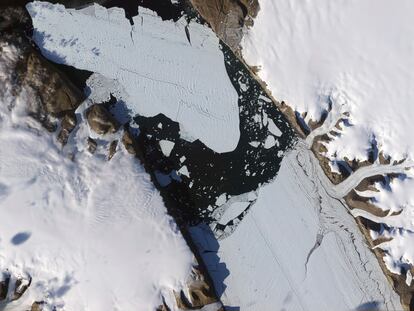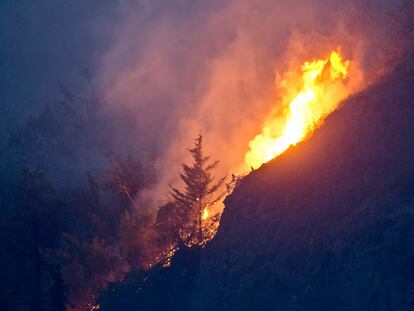Warming-stoked tides eating huge holes in Greenland glacier
Warmer water from climate change is eating a large hole deep inside the glacier and accelerating ice loss at its key connection point with the ocean floor. The hole is bigger than the Washington Monument

Daily tides stoked with increasingly warmer water ate a hole taller than the Washington Monument at the bottom of one of Greenland’s major glaciers in the last couple years, accelerating the retreat of a crucial part of the glacier, a new study found.
And scientists worry that the phenomenon isn’t limited to this one glacier, raising questions about previous projections of melting rates on the world’s vulnerable ice sheets.
The rapid melt seen in this study was in the far northwest of Greenland on Petermann Glacier. If it is happening in the rest of Greenland and the even bigger Antarctic ice sheet, then global ice loss and the sea level rise could jump as much as twice as fast as previously thought, according to the study in Monday’s Proceedings of the National Academy of Sciences.
“It’s bad news,” said study author Eric Rignot, a glaciologist at University of California Irvine. “We know the current projections are too conservative. We know that they have a really hard time matching the current record’' of melt.
He said this newly found consequence of tidal activity “could potentially double the projections” of global melt.
The study looks at the all-important grounding line area of glaciers on ice sheets. That’s the point where glaciers go from being on land to floating on water. Previous studies show it’s also a key spot for rapid ice loss.
At remote Petermann, where few people have been and there are no base camps, that grounding line zone is more than six-tenths of a mile (1 kilometer) wide and could be as much as 3.7 miles (6 kilometers) wide, the study said.
Scientists used to think the daily tides weren’t a big deal on melt. The snow added on top of the glacier compensated for the tides moving further in, said Rignot, the day before he left for an expedition to Petermann.
But with an ocean that’s warmer because of climate change the tides became “a very powerful mechanism,” Rignot said.
“The sea water actually goes much farther beneath the grounded ice (than previously thought), kilometers, not hundreds of meters,” Rignot said. “And that water is full of heat and able to melt the glaciers vigorously. And it’s kind of the most sensitive part of the glacier.”
Using satellite altitude measurements, Rignot’s team found a 669-foot tall (204 meters) cavity at the grounding line where the melt rate is 50% higher in the last three years than it was from 2016 to 2019. Previous models forecast zero melt there.
The melting in Petermann has accelerated in the last few years, later than the rest of Greenland, probably because it is so far north that the water melting it from underneath is from the North Atlantic and it takes longer for the warmer water to reach there, Rignot theorized.
Rignot this month is exploring Petermann to get more ground-based measurements using ultrasound. He hasn’t been there since 2006, a decade before the changes were seen via satellite. Visiting Petermann, even before the glacier’s retreat accelerated, Rignot said he noticed movements that make it seem like a living thing.
“When you are standing on that shelf or sleeping on the shelf you hear noise all the time, loud noises from deep inside cracks forming,” Rignot said. “That’s where the concept of a glacier being alive starts getting to you.”
Greenland ice researcher Jason Box of the Geological Survey of Denmark and Greenland, who wasn’t part of the research, called Rignot’s technique clever and said the study makes sense, showing “that ocean heat delivery to tidewater glacier grounding lines represents a potent destabilizing effect.”
Box, who uses a different technique to calculate how much ice is no longer being fed by glaciers and is doomed to melt, something called “zombie ice,” figures 434 billion metric tons of ice on Petermann is already committed to melting.
The study provides strong evidence that models need to include these tidal effects deep inland and if they don’t, then they are underestimating future sea level rise, said Pennsylvania State University glaciologist Richard Alley, who wasn’t part of the Rignot study.
Sign up for our weekly newsletter to get more English-language news coverage from EL PAÍS USA Edition
Tu suscripción se está usando en otro dispositivo
¿Quieres añadir otro usuario a tu suscripción?
Si continúas leyendo en este dispositivo, no se podrá leer en el otro.
FlechaTu suscripción se está usando en otro dispositivo y solo puedes acceder a EL PAÍS desde un dispositivo a la vez.
Si quieres compartir tu cuenta, cambia tu suscripción a la modalidad Premium, así podrás añadir otro usuario. Cada uno accederá con su propia cuenta de email, lo que os permitirá personalizar vuestra experiencia en EL PAÍS.
¿Tienes una suscripción de empresa? Accede aquí para contratar más cuentas.
En el caso de no saber quién está usando tu cuenta, te recomendamos cambiar tu contraseña aquí.
Si decides continuar compartiendo tu cuenta, este mensaje se mostrará en tu dispositivo y en el de la otra persona que está usando tu cuenta de forma indefinida, afectando a tu experiencia de lectura. Puedes consultar aquí los términos y condiciones de la suscripción digital.
More information
Últimas noticias
Sydney Sweeney, the actress praised by Trump: ‘Women are up against what society wants them to be’
The Bolsonaro surname: An advantage or liability in Brazil’s 2026 presidential elections?
Raúl Rocha, from jet-setting with Miss Universe to arms trafficking and fuel theft
80,000 barrels of Mexican oil sent to Cuba: Havana drawn into the US–Mexico clash
Most viewed
- Reinhard Genzel, Nobel laureate in physics: ‘One-minute videos will never give you the truth’
- Pablo Escobar’s hippos: A serious environmental problem, 40 years on
- Charles Dubouloz, mountaineering star, retires at 36 with a farewell tour inspired by Walter Bonatti
- Why we lost the habit of sleeping in two segments and how that changed our sense of time
- The fall of a prolific science journal exposes the billion-dollar profits of scientific publishing










































